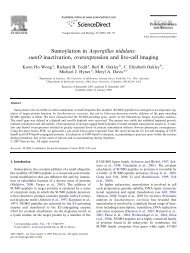Ice nucleation active bacteria and their potential role in precipitation
Ice nucleation active bacteria and their potential role in precipitation
Ice nucleation active bacteria and their potential role in precipitation
Create successful ePaper yourself
Turn your PDF publications into a flip-book with our unique Google optimized e-Paper software.
ERCA 6 91<br />
Figure 2. Scann<strong>in</strong>g electron microscope image of a <strong>bacteria</strong>l biofilm naturally occurr<strong>in</strong>g on the leaf of broad-leaved<br />
endive. The biofilm is sitt<strong>in</strong>g on the amorphous cuticular wax characteristic of the leaf surface of this plant. The<br />
exopolymeric matrix enrob<strong>in</strong>g this biofilm, which is normally well hydrated, has been partially destroyed dur<strong>in</strong>g the<br />
desiccation of the sample necessary to prepare it for microscopic observation.<br />
are higher on older leaves at lower parts of the plant [40, 41] which are shielded from direct sunlight, may<br />
experience higher relative humidity or may exude more nutrients. There is also considerable fluctuation of<br />
<strong>bacteria</strong>l populations over short time periods <strong>and</strong> over an entire grow<strong>in</strong>g season. Monitor<strong>in</strong>g populations<br />
of INA <strong>bacteria</strong> on bean leaves at regular time <strong>in</strong>tervals dur<strong>in</strong>g 24 hour time periods showed that this<br />
fluctuation can exceed one order of magnitude (over 10-fold differences between high <strong>and</strong> low population<br />
sizes per leaf). The lowest populations of <strong>bacteria</strong> were observed dur<strong>in</strong>g the warmest time of the day<br />
[42]. Interest<strong>in</strong>gly, the decrease <strong>in</strong> population sizes co<strong>in</strong>cided with the period of maximum immigration<br />
of <strong>bacteria</strong> from the plant surface. Flushes of <strong>bacteria</strong>l populations on leaves also seems to co<strong>in</strong>cide with<br />
ra<strong>in</strong>, but <strong>in</strong> particular with <strong>in</strong>tense ra<strong>in</strong> falls. The momentum of the ra<strong>in</strong>, rather than simply the quantity<br />
of ra<strong>in</strong> water fall<strong>in</strong>g, is an essential factor for these flushes [43].<br />
As mentioned previously, there is an important diversity of microorganisms on aerial plant surfaces.<br />
Here, we have made particular reference to <strong>bacteria</strong> that are plant pathogens or that are <strong>active</strong> as ice<br />
nuclei, the latter group occurr<strong>in</strong>g commonly on a wide variety of plants particularly <strong>in</strong> temperate regions<br />
[44]. But it must be kept <strong>in</strong> m<strong>in</strong>d that these <strong>bacteria</strong> co<strong>in</strong>cide with <strong>and</strong> are likely to <strong>in</strong>teract with hundreds<br />
of other species of <strong>bacteria</strong> <strong>and</strong> other types of microorganisms <strong>and</strong> <strong>in</strong>sects. The processes <strong>in</strong>volved <strong>in</strong><br />
colonization of plants <strong>and</strong> <strong>in</strong> aerial dissem<strong>in</strong>ation evoked for INA <strong>and</strong> plant pathogenic <strong>bacteria</strong> are also<br />
pert<strong>in</strong>ent to these other organisms.<br />
4. DISCOVERY OF THE ICE NUCLEATION ACTIVITY OF BACTERIA<br />
Historical themes <strong>in</strong> the various branches of science have an amaz<strong>in</strong>g similarity. Discovery marches<br />
through several layers of complexity, start<strong>in</strong>g with some <strong>in</strong>itial <strong>and</strong> often startl<strong>in</strong>g observation, followed<br />
by a description phase, then by explanation <strong>and</strong> even application <strong>and</strong> an over-all manipulation [45]. The<br />
first observation is often made by someone <strong>in</strong> a peripheral field. This certa<strong>in</strong>ly appears to be the case for<br />
INA <strong>bacteria</strong>. Although all of the groups of <strong>bacteria</strong> capable of ice <strong>nucleation</strong> are usually associated with<br />
plants, they were first recognized as catalysts of ice formation by meteorologists [46-48]. The French<br />
meteorologist Soulage was the first to identify <strong>bacteria</strong>l cells <strong>in</strong> an ice crystal [49] although he did not









